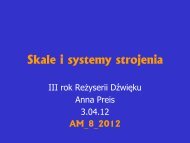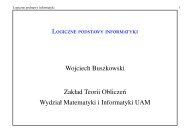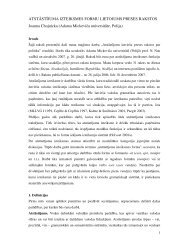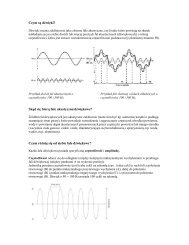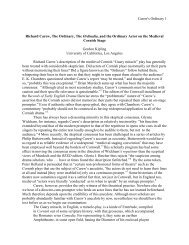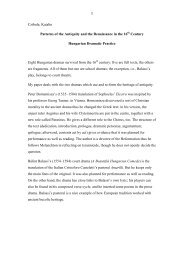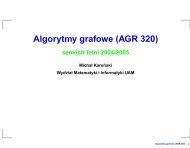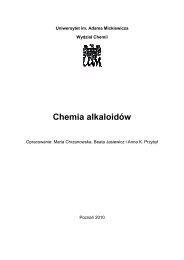Apposition
Apposition
Apposition
Create successful ePaper yourself
Turn your PDF publications into a flip-book with our unique Google optimized e-Paper software.
Investigationes Linguisticae, vol. X, Pozna<br />
, December 2003<br />
<strong>Apposition</strong><br />
Michel Paladian<br />
Armenian State University<br />
e-mail: michel73@yandex.ru<br />
Abstract<br />
The term <strong>Apposition</strong> has given rise to many disputes over its range of occurrence and its<br />
affinity with the Epithet. This article is an attempt to detect theoretical and logical ambiguities<br />
concerning the <strong>Apposition</strong> in the analyses of Armenian and French syntax. After a brief<br />
presentation of “contradictions”, the author tries to explore the internal logic which caused<br />
them. Then, the problem is reviewed again in the light of the cognitive grammar.<br />
1. Introduction<br />
The definition of the term <strong>Apposition</strong> generates already some confusion: the term derives from<br />
Latin apponere which means ‘to put at side.’ Unfortunately, the term Epithet, being of Greek<br />
etymology ( ), is defined identically: ‘one which is put at side’. These two definitions<br />
concern a syntactic position and neglect lexical and semantic dimensions.<br />
Obviously, on a semantic level, the <strong>Apposition</strong> and the Epithet are not found with identical<br />
sememes, and a clear distinction is possible. They are both the extensions of the noun, but in<br />
different ways. S. Abrahamian [1975:287], an Armenian contemporary linguist, tries to define them<br />
in the following way:<br />
<strong>Apposition</strong> is a complement of the noun by which is expressed what the noun is.<br />
Epithet supplements the name and expresses such or such feature of the referent.<br />
What the noun is and a feature of the referent say a priori the same thing, and the attempt of a<br />
clear-cut distinction seems to fail. It is necessary to avoid making the <strong>Apposition</strong> simply a detached<br />
Epithet. A question arises here, whether an adjective can be used as the <strong>Apposition</strong>.<br />
(1) Le feu dance sur la Seine, fou et violent.<br />
Fire dances in the Seine, insane and violent.<br />
In this case, there are simply two detached Epithets. It can be seen below that <strong>Apposition</strong> cannot<br />
leave the limits of the noun (1). The extreme category form such constructions as Le roi soleil (The<br />
King Sun) where the <strong>Apposition</strong> is on the verge of decategorization (noun > adjective). Damourette<br />
and Pichon [1935] consider the second noun (soleil) to be not the <strong>Apposition</strong>, but the Epithet.<br />
Obviously, the problems dealt with here are rather hazy. A specialist on the Armenian syntax,<br />
R. Iskhanian, avoids defining the <strong>Apposition</strong>. His book [1986:167] devoted to the Armenian syntax<br />
does not give any such a definition at all. Even the definition by P.H. Matthews in Concise<br />
dictionary of linguistics [1997:22] appears somewhat vague: <strong>Apposition</strong>: A syntactic relation in<br />
which an element is juxtaposed to another element of the same kind, especially between noun<br />
phrases that do not have distinct referents, e.g., ‘Lucienne’ is in <strong>Apposition</strong> to ‘my wife’ in ‘Do
Investigationes Linguisticae, vol. X<br />
you know my wife Lucienne?’ Elements are seen as parallels but do not have distinct roles in a<br />
larger construction, e.g. ‘Smith’ is seen as apposed to ‘Captain’ in ‘Do you know Captain Smith?’<br />
and are distinguished from *modification (or attribution) in that there is no clear tendency for<br />
either element to qualify the other.<br />
How to decide whether a qualification is ‘clear’ or not? In both cases, we deal with the<br />
qualification, two cases of predication.<br />
Purely positional analyses, i.e., the definition of the <strong>Apposition</strong> according to the occupied<br />
place, appear to be the most vague. At the beginning of the previous century, an Armenian linguist,<br />
M. Abeghian [1965:509], decided that the <strong>Apposition</strong> could only be placed after [the noun] (sic!).<br />
However, a criterion remains unknown. The <strong>Apposition</strong> is regularly put after the name that it<br />
supplements and takes the same case, the same number and the same person [M. Abeghian 1965].<br />
That caused the following aberrations. R. Iskhanian [1987:167] gives initially the following<br />
example of the <strong>Apposition</strong>:<br />
(2) Kancum er torane ‘ Astrikin.<br />
Verb [Past continues] + Noun [ Accusative] + Proper Noun-<strong>Apposition</strong><br />
‘He called his small daughter ‘Astrik’’.<br />
Astrikin is regarded here as the <strong>Apposition</strong>. Some pages afterwards, we find the following example,<br />
where Vartane is regarded as the <strong>Apposition</strong>. Unfortunately for the author Vartane is not postposed.<br />
(3) Ekav Vartane‚ erbayrs.<br />
Verb [Present Perfect] + Proper Noun [Nominative] + Noun-<strong>Apposition</strong> with Possessive article<br />
‘Vartan came, my brother’.<br />
But the confusion does not stop at Armenian. Even an established researcher, H. Béchade, leads<br />
himself in a trap because of the lack of the semantic and syntactic discriminatory definitions. In<br />
[Béchade 1993], one finds the following example, in which soldat is regarded as the <strong>Apposition</strong>:<br />
(4) Soldat, il a fait de nombreuse campagnes.<br />
‘As a soldier he has participated in many campaigns’.<br />
(In fact, soldat is here only Manner Adjunct.)<br />
Is it necessary to integrate dislocations (left and right) into <strong>Apposition</strong>? The debate [Forsgren 1991,<br />
1993; Lago 1994; Picabia 1991; Neveu 1995; Raabe 1979] around the <strong>Apposition</strong> is far from being<br />
finished. Combettes [1998], in order to reconcile everyone proposes the term of detached<br />
construction. Combettes [1998: 17-28] and Forsgren [1988: 143], [1991: 605-606] distinguish the<br />
following types which can constitute a detached construction:<br />
• Nouns and pronouns: Auteur de «Mme Bovary», Zola aurait connu plus rapidement le<br />
succès... (As the author of « Madam Bovary » Zola would have had a more rapid success...)<br />
• Adjectives, past participles or corresponding prepositional syntagms: Cet homme qu’on<br />
évacue, en chaussettes, inanimé, c’est un conseiller d’Etat...<br />
• Absolute constructions: Ils s’en vont, hirsutes, les yeux ravagés par la peur...<br />
• Present participles: Regardant à sa gauche, il vit le facteur qui sortait de sa maison...<br />
Combettes [1998] counts also Gerund among detached constructions. Forsgren takes into account<br />
other forms:<br />
• Adverbial syntagms: ...un écrivain qui lève son verre pour répondre à un toast d’hommes<br />
en smoking, debout autour de la table...<br />
• Relative subordinate clauses (explanatory): Sartre, qui réfléchissait déjà sur une<br />
perception, l’image, l’imaginaire, reprenait la thèse d’Alain...<br />
• Infinitives: Il n’a qu’une idée: s’évader
Michel Paladian: <strong>Apposition</strong><br />
• Space or temporal constructions: Ce premier ministre légendaire, de 1946 à 1969,<br />
personnalité d’abord froide et austère, [...], savait repérer les jeunes talents politiques...<br />
Lago [1994] goes until the title of his article: Is the <strong>Apposition</strong> a function or a mode of construction?<br />
However, calling the <strong>Apposition</strong> – the mode of construction we can not solve the issue.<br />
2. The morpho-syntactic level<br />
Generally two words W1 and W2, denoting respectively sets of entities E1 and E2, are in one of the<br />
following relations:<br />
1. Identity: E1 = E2<br />
2. Inclusion: E2 is included into E1.<br />
3. Overlap: E1 and E2 have a non-empty intersection, but one is not included in other.<br />
4. Disjunction: E1 and E2 have no element in common.<br />
The <strong>Apposition</strong> should enter the third case. But where is the common element and what is it? Let<br />
us see the situation from a syntagmatic point of view. Syntagmatics is presented in general in the<br />
following way:<br />
Fig.1. Types of prepositional construction<br />
The juxtaposition, even if it really exists semantically, can be recognized by no overt<br />
morphological indications. The co-variation can be recognized by feature congruity, i.e.,<br />
compatibility of values of identical grammatical categories of syntactically combined linguistic<br />
items. The government relation is present when there is the determination of one element by the<br />
inflectional form of the other. It can be said at the beginning of our analysis that the <strong>Apposition</strong><br />
falls under the co-variation. In HPSG it will be presented as follows:<br />
(3) Ekav Vartane‚ erbayrs.<br />
Verb [Present Perfect] + Proper Noun [Nominative] + Noun-<strong>Apposition</strong> with Possessive article<br />
Vartan came, my brother.<br />
Fig. 2. Description of the <strong>Apposition</strong> in HPSG
Investigationes Linguisticae, vol. X<br />
But this is just a description and not an explanation. Let us return to the problem. It seems that if<br />
the true function (on the basis of its cognitive dimension) of the <strong>Apposition</strong> is found, one should<br />
also be able to seize its core property and to say what the <strong>Apposition</strong> is. There exists a semantic<br />
(conceptual) solution which would allow the clear distinction between the <strong>Apposition</strong> and the<br />
Epithet.<br />
At this morphosyntactic level, it is impossible to say that the <strong>Apposition</strong> has a definitely fixed<br />
position. In fact, the semantic roles decide about the positions and consequently about the<br />
<strong>Apposition</strong>s which could supplement them. The <strong>Apposition</strong> can be pro-posed as well as post-posed.<br />
Combettes [1998:67] recognizes that it can be placed after its support or occupy the initial position<br />
in the sentence. The criterion of the definition can be only semantic and pragmatic (2). And it must<br />
be restrictive. For this reason, it would be appropriate to give a particular status to the <strong>Apposition</strong> –<br />
Genitive syntagm (La vile de Paris). Contrary to the normal Genitive system, the Relational<br />
<strong>Apposition</strong>, as can be seen below, does not have a syntactic head, i.e., two elements have the same<br />
function – the Concordial Case. Noun 2 is also a nominal head and can receive the <strong>Apposition</strong> in its<br />
turn:<br />
(5) Arsenal, the champion of England, the inventor of football, gained a victory.<br />
3. Predication with the <strong>Apposition</strong>: Towards the first solution<br />
Let us examine the semantic (conceptual) dimension. Davidson [1967] announced the presence of<br />
two or more predications, i.e., the existential quantification over an event which is not explicitly<br />
present in the surface structure. Given that we want to convey two units of information, there is<br />
often a choice between presenting them separately, one by one, or as one piece. For instance, we<br />
may say: This is a man and he is unmarried. It is not far from the position of Fauconnier [1996]. It<br />
is a Blending – a conceptual integration of related events into one complex event. The following<br />
sentence could be rewritten in the following Davidsonian way:<br />
(6) Paul a frappé Pierre.<br />
∃e frapper (e, Paul, Pierre).<br />
It can be observed that the <strong>Apposition</strong> functions like a specific predication. Like the predication,<br />
any <strong>Apposition</strong> presupposes the verb to be. Some linguists do not hesitate to give it the status of a<br />
hidden Attribute. The <strong>Apposition</strong>, in spite of co-reference, could be regarded as a second entailed<br />
sentence. It does not form a part of the principal argumental system.<br />
But as a predicative noun, it concerns the second predication (the second focal adjustment of<br />
selection) – the second operative time when the world is perceived analytically<br />
(metadiscoursively).The first names an existential event (or what is posed like the existential event),<br />
the second supplements it. On a cognitive level, the <strong>Apposition</strong> should be registered apart from the<br />
existential event which indicates the static face of the trajectory [cf. Fig. 3]. Let us specify that<br />
static does not mean aperspectival as the 2 nd predication <strong>Apposition</strong> enters the prospect of the<br />
sentence.
Michel Paladian: <strong>Apposition</strong><br />
tr bis – trajectory of <strong>Apposition</strong>: Metadiscourse (the second focal adjustment of<br />
selection)<br />
lm – landmark<br />
tr – trajectory of Existential Event Entity: Discourse (the first focal adjustment of<br />
selection)<br />
Fig. 3. Cognitive Approach to the <strong>Apposition</strong><br />
The second predication (the <strong>Apposition</strong>) is a predication of a particular type. It would be more<br />
judicious to regard it as a counterpart to the noun phrase which it supplements. The <strong>Apposition</strong> and<br />
the Attribute testify to the dialogue of an underlying structure. The <strong>Apposition</strong> is a relation built<br />
like a relation which does not have certain prototypical characteristics of the canonic syntactic<br />
relations. One of its components is a non-mediate relation by a context matrix, data ontologically<br />
autonomous, independent (but not separated) static identification compared to the event which is<br />
described in the context matrix. On the cognitive level, we could say that the first predication<br />
concerns what I see, whereas the second what I see of what I saw.<br />
The problem is that the Epithet also predicates, as the generative grammar has already shown<br />
it. I saw a black dog is built on two levels:<br />
(7 a) I saw a dog.<br />
(7 b) This dog was black.<br />
Where is the difference then between the <strong>Apposition</strong> and the Attribute? Contrary to the <strong>Apposition</strong><br />
which is appellative the Epithet does not assign a new position, as a semantic role, the function<br />
reserved for the noun. It is the Epithet that is on standby of support, not the <strong>Apposition</strong>. The Epithet<br />
is dependent. However, there is also the problem of temporality to take into account.<br />
If the attribute adjective is the expression of a temporal attribution (verbal intendment in<br />
time), the epithet adjective marks a timeless attribution (adjectival intendment in space). But the<br />
same applies to the <strong>Apposition</strong> when compared to the nominal Attribute: it marks timeless<br />
identification in space. The Attribute can associate only with the subject and direct object, whereas<br />
the <strong>Apposition</strong> can associate with all the arguments (even adjuncts). Unfortunately, this distinction<br />
cannot solve the problem entirely.<br />
Without a clear distinction between characterization and identification (two phases of<br />
topicalization), the analysis risks to get bogged down in explanations. The characterization does not<br />
return to designation, but to the property which the referent of the noun has. Thus in a sentence<br />
like:<br />
(8) Paul boit son café chaud.<br />
(Paul drinks his coffee only hot.)<br />
chaud should not be regarded as the <strong>Apposition</strong> [Scheppers 1999] but as the Attribute of the object.<br />
Chaud predicates intentionally that chaud is a general sememe, not identifying THE COFFEE of<br />
Paul (a feature is not stable) whereas small daughter [cf. Example (2)] was predicating<br />
extensionally that small daughter is a sememe concerning only Astrik (a feature was stabilized with
Investigationes Linguisticae, vol. X<br />
a real referent). The small daughter is the +marked Patient in the argumental system, i.e., the<br />
recognized Patient.<br />
The <strong>Apposition</strong> thus refers to and informs simultaneously. The reason is that it does not<br />
repeat. The same one does not bring any information. Therefore, the function of the <strong>Apposition</strong> is<br />
to bring a new piece of information as identification (like autonomous information). It is not also a<br />
“photo” of the Noun 1 without clear contents (it would slip in this case towards the pronoun).<br />
From a localist point of view, it may be said that the <strong>Apposition</strong> becomes necessary since each<br />
phrase predicates about the location of one entity only [Langacker 1987]. The <strong>Apposition</strong> carries a<br />
presupposed location. Uttering a sentence, the speaker intends a particular object to be salient to the<br />
hearer and this intention constitutes the internal, inseparable property of the constructed<br />
representation. In the appositive statements, noun phrase 1 is chosen by the Perceiver, whereas the<br />
noun phrase 2 which brings information is chosen by the Cognizer. The errors of localization of the<br />
<strong>Apposition</strong> come owing to the fact that it is systematically considered as a separate entity. But this<br />
is the relation between the Perceiver and the Cognizer – between two conceptual dimensions. The<br />
argumental selection is made so that the first discursive choice should be realized (Arsenal). The<br />
<strong>Apposition</strong> is a correction of this choice, a correction located on the analytical plan (the champion<br />
of England).<br />
(9) Arsenal, the champion of England, the inventor of football, gained a victory.<br />
Thinking always begins with suggestive but imperfect plans and images; they are progressively<br />
replaced by better, but usually still imperfect, ideas. Because of the schematical assumption and its<br />
implications for human memory – says Barsalou [1998:12] – we should be surprised if the<br />
cognitive system ever contains a complete representation of an individual.<br />
Referential situations are organized in terms of successive, nested and collocated<br />
specifications and re-specifications of figured aspects against grounded aspects. In Elements of<br />
structural syntax, Tesnière [1969:165] gives the example of the <strong>Apposition</strong> on the way to become<br />
the Circonstant of Concession (a comment): (...) In the sentence Remarkable Speaker, Attics was a<br />
poor writer, if the quality of poor writer is allotted to Atticus by attribute, it is a different quality<br />
and in opposition with the first which is lent to him by <strong>Apposition</strong>, so the <strong>Apposition</strong> can develop<br />
in the direction of a concessive circonstant: Though remarkable speaker, Atticus was a poor writer.<br />
Remarkable Speaker is obviously a subordinate clause of concession (metadiscourse) which<br />
semantically corrects (modifies) the principal one.<br />
4. About semantic dependency<br />
As it was mentioned above, the <strong>Apposition</strong> is the predication of a special type. Starting from the<br />
following definition of the predicate: One of the two main constituents of a sentence or clause,<br />
modifying the subject and including the verb, objects, or phrases governed by the verb, as opened<br />
the door in Jane opened the door or is very sleepy in The child is very sleepy. [The American<br />
Heritage Dictionary of English Language: 4 th edition, 2000], it can be said that the <strong>Apposition</strong><br />
predicates –because they share the same referent it is usually possible to insert who /which / is /<br />
are between them: my friend, who is John. [Hudson 2001]. As the Predicate, it enters a system of<br />
dependency (syntactic, semantic and morphological). The Predicate conceptually has not<br />
autonomous meaning which is used in combination with some other meaning (its argument) to<br />
convey the referent of that argument.<br />
It is possible for two constituents to be co-referent, i.e., to be in a semantic relation of coreference,<br />
without any syntactic binding relationship (syntactic dependency) between them. There<br />
is, for example, the definition of R. Hudson [2001]: One of the most general traditional types of<br />
construction, alongside with subordination and coordination. A typical example of the <strong>Apposition</strong><br />
is my friend John. If two words are in <strong>Apposition</strong>, they:<br />
• are next to each other (except for their own dependents) so that they can be considered as a<br />
simple phrase – My friend John is one phrase,
Michel Paladian: <strong>Apposition</strong><br />
• have the same referent, i.e., John (<strong>Apposition</strong> involves co-reference),<br />
• they may or may not be separated, according to meaning. In speech, they may or not may<br />
be separated by intonation), e.g. My friend John or My friend, John.<br />
Because they share the same referent it is usually possible to insert who / which / is / are between<br />
them – My friend, who is John.<br />
Although the <strong>Apposition</strong> is traditionally contrasted with subordination, i.e., dependency, it can<br />
easily be included in a dependency analysis, as a kind of dependency. It is clear that the second<br />
word depends on the first. But what does a kind of dependency mean? The given example (my<br />
friend John) can be considered in two ways:<br />
1. I do not think that there is the <strong>Apposition</strong> in the construction my friend John. The system<br />
cannot be broken up. It is to be regarded as one word only. There would be the case which<br />
H. Frey [1929] called condensation and which Givon [1979] calls loose parataxis.<br />
2. If there is dependency, friend is the <strong>Apposition</strong> and not John. Listeners attempt to build up<br />
a sentence's interpretation gradually. To do it, they need to have the starting point fully<br />
identified, since it is the basis for the rest of the interpretation. Gernsbacher [1990] has<br />
shown that the initial nominal phrase has the predicated advantage of first mention. This<br />
advantage makes the first noun more memorable and more accessible for further<br />
meaningful processing. The starting point must be referential. It is not intrinsic dependency,<br />
registered in the syntagm, but inferential dependency.<br />
To configure something as +determined, it is often enough to represent a universally known<br />
concept.<br />
(10) Travailler, chose nécessaire à tous...<br />
(To work, a useful thing for everybody…)<br />
A new question emerges, i.e., what the difference is among the <strong>Apposition</strong>, the Epithet and the<br />
Attribute. Using which is we fall into the Attribute predication, which Hudson gives the following<br />
definition: Relationship between two concepts which identifies one as a property of the other.<br />
The <strong>Apposition</strong> is the predication of a special type, if one starts from such a definition [of the<br />
predicate]: Predicate conceptually has no autonomous meaning which is used in combination with<br />
some other meaning (its argument) to convey the referent of that argument. Of course all linguistic<br />
expressions are considered here as the predicate in that they are distinguished from one another on<br />
basis of the location [Langacker 1991: 547]. But various kinds of predication have to exist.<br />
One can say that the <strong>Apposition</strong> and the Attribute constitute anticipatory calculation on behalf<br />
of the speaker – the epistemic ground according to Langacker [1987:127]. They anticipate the<br />
reception of the message (the Principles of Grice are useless to point out here) and provide<br />
additional information. The <strong>Apposition</strong> and the Attribute testify to a dialogue of underlying<br />
structure. The Attribute does it by the focused recovery of such or such close feature of the noun.<br />
<strong>Apposition</strong> does it by a reference to a common knowledge, i.e., by reduplication of +new<br />
information. The speaker re-elects the referent by periphrasis which contains also some additional<br />
information. For this reason, do we have to consider dislocations (left and right) as <strong>Apposition</strong>s –<br />
the cases of anaphora (the projection of semantic roles)? It is often heard in France today to be said<br />
by the politicians:<br />
(11) Les Français, ils veulent la sécurité.<br />
(The Frenchmen, they want safety.)<br />
They can be held very well as the <strong>Apposition</strong> (a reduplication) of the Frenchmen. It will then<br />
receive new semantics – a signification close to: my friends... these which love me... share my<br />
ideas and which you know, etc. But such information can not be directly observed, and all<br />
dislocations (left and right) are not <strong>Apposition</strong>s; they does not bring any new information compared
Investigationes Linguisticae, vol. X<br />
to the Frenchmen. They presuppose pronominalization. The concept of dislocation takes place<br />
when the sentence is already given. The <strong>Apposition</strong> does not renew equivalent units (3).<br />
It seems to be necessary, in the final analysis, to admit that the <strong>Apposition</strong> presupposes a<br />
cognitive movement going from the noun 1 towards the noun 2 – a kind of dependency. Langacker<br />
locates this mechanism in, what he calls, the active zone analysis. In active zone analysis the<br />
relational predication – a verb, adjective, adverb or preposition – adjusts its meaning to<br />
accommodate its semantic argument. The author of the present article claims that all items have the<br />
active zone. But the relational predication of the <strong>Apposition</strong> is made in the other way than the<br />
Attribute's relational predication. It is not a question of total dependency.<br />
In the Hudson’s example, the identification (the <strong>Apposition</strong>) can be done by John. However,<br />
is it real dependency – a predication like with the Attribute when John is a monosemous and selfsufficient<br />
word? The noun John is not an inherent (intrinsic property) of Friend and it has a<br />
relational nature (extrinsic property). John refers, but does not really describe. Names – Perry<br />
specifies [1997:6] – refer, i.e., they contribute to the official content of the individual they<br />
designate. Definite descriptions describe, i.e., they contribute to the official content of the mode of<br />
presentation their meaning associates with them.<br />
If small daughter can characterize Astrik (bring information by naming a property of), the<br />
reverse is not possible, since Astrik by its status of a Proper noun (indicating what is single and<br />
being inherently definite) cannot characterize a small daughter. Astrik can be a small daughter, but<br />
a small daughter cannot be Astrik. Astrik is not an inherent sememe of a small daughter. We had<br />
the same phenomenon with my friend John where the alternative my friend who is John is<br />
unacceptable. If we take the principles of selective binding, a question emerges – Which feature<br />
does John select in the nominal head friend? Does there exist any John (an individual) in friend? As<br />
a Proper noun, John cannot predicate. John is a rigid designator. It is referring but not describing.<br />
Proper nouns are not associated with any description of the individuals they refer to, but are<br />
directly attached to their referents by the act of naming or “baptism”. Judgments that we make<br />
about the referent are essentially retrospective. The reference is affected by what we will do as<br />
much as by what we have done.<br />
Someone – Kripke says [1980:70] – uses the name ‘Socrates’. How are we supposed to know<br />
to whom he refers? By using the description which gives the sense of it. According to Kneeled, the<br />
description is ‘the man called Socrates’. (...) We ask: To whom he refers by ‘Socrates’? And the<br />
answer is given: Well, he refers to the man to whom he refers. If this were all there was to meaning<br />
of a proper name, the no reference would get off the ground at all.<br />
It remains to distinguish again between identification and attribution (characterization) and in<br />
a certain way, reference from description. In the syntagm la vile de Paris, it is perhaps la vile which<br />
is the <strong>Apposition</strong> (like friend in the syntagm my friend John). Sometimes the deictic has to be<br />
considered to function like <strong>Apposition</strong>s (the inferential information provided by the context), but<br />
how to know if John and Paris are deictic here or not? It is true that the deictic can be added to the<br />
identification and informativeness must be measured with reference to the hearer of the message.<br />
The Epithet (characterization) is in direct dependency (forms a block) on the noun which it<br />
accompanies; The Epithet realizes a sememe already contained in the noun. Thus, it does not add<br />
new external information. The Epithet, contrary to the <strong>Apposition</strong> which opens a new location,<br />
does not allot a new location. It widens what has existed already. The semantic vicinity does not<br />
mean membership in the same semantic universe.<br />
5. The pragmatic level<br />
The above-mentioned differences have their equivalent in the pragmatic plan. At first sight, the<br />
pragmatic base seems to be the same for the <strong>Apposition</strong> and Attribute. Speakers engaged in<br />
conversation are guided by Relevance Maxim [Grice 1975], whereby they will relate their<br />
contribution to what the other participants in conversation are saying. We find the problems of the<br />
double predication with different entailment. Let us return to the earlier example (8).<br />
(8) Paul boit son café chaud.<br />
(Paul drinks his coffee hot.)
Michel Paladian: <strong>Apposition</strong><br />
Thus, it is necessary to continue to consider two predications (two speech acts); the second<br />
supplementing the first:<br />
(8 a) Paul prend son café.<br />
(Paul drinks his coffee.)<br />
(8 b) Son café est chaud.<br />
(His coffee is hot.)<br />
The utterance (8) implies a priori and covertly: Paul does not like cold coffee (a response to a<br />
proposal of the kind: Not as cold as you think). There are two speech acts. The adjective chaud<br />
opens on the context. Compare it with:<br />
(12) Paul prend un café chaud.<br />
It can be seen that we have some semantic (and syntactic) shortening and that chaud has integrated<br />
(internal characterization) the noun coffee which it characterizes. There are two clauses but one<br />
speech act. The utterance (11) does not imply. It presupposes (Paul drinks coffee). Examine now<br />
the following sentence:<br />
(13) Paul prend du Nescafé, un café soluble.<br />
(Paul drinks Nescafé, instant coffee.)<br />
Here are two clauses and two speech acts. The <strong>Apposition</strong> exhausted the semantics of Nescafe in<br />
the sense that it defined extensionally (it is directed to the known world). Probably, it comes from<br />
the fact that Nescafé is universally known. The <strong>Apposition</strong> implies a posteriori and overtly.<br />
Langacker [1991:89] distinguishes two types of grounding predications: (1) those which identify<br />
an instance with reference to a more inclusive class (mass reference), and (2) those which focus on<br />
a degree of definiteness, i.e., it is the instance presented by the speaker as known to the hearer and<br />
takes the ground (the speaker and the hearer) as their reference point.<br />
That explains the fact that the <strong>Apposition</strong> cannot accept modality – it would slip towards the<br />
detached Epithet:<br />
(14) Le remarquable chef de l’actuel gouvernement afghan, Hamid Karazaï,...<br />
(The remarkable chief of the actual Afghan government, Hamid Karzai…)<br />
6. The other litigious example<br />
Let us return now to the other example given by an Armenian linguist Rafael Ishkhanian. It relates<br />
to the predicated personal Pronoun (a tonic pronoun).<br />
(15) Es inks Tessa.<br />
Personal pronoun, first person + Adjective (?) (myself) + Verb [ Present perfect ]<br />
(I have seen myself.)<br />
The analysis begins with a question: why do the French put a hyphen between me (mol) and even<br />
(même): mol-même? If the restrictive definitions proposed here are applied, it leads to the following<br />
situation. On a cognitive level, même marks salience (the profile of moi which is the ground) and<br />
the salience is due to a separation: an entity X is duplicated by an entity X’. The French would<br />
consider that there is ‘a clone’ and not intentional renewal (characterization) of a sememe<br />
contained in X. A point of view has changed – it is now external. Second time, X is seen outside. In<br />
English there is only one word (myself) – considering that conceptual identity can not cause a<br />
lexical separation: a case of ‘condensation’. But this word marks the membership: my + self.<br />
Nevertheless, the relation between an entity and the other one is obtained (designation with
Investigationes Linguisticae, vol. X<br />
predication) – I have a self or the self of me, i.e., a noun complement or a relational adjective (the<br />
Epithet).<br />
Does it mean that même could be regarded as the Epithet of moi? It seems that it is not the<br />
case. The noun complement or the relational adjective does not characterize. For example, equine<br />
in a equine butchery says nothing on the essence of butchery. It could be a bovine butchery as well.<br />
The same problem exists in the cases of presidential in presidential reception. Then même will not<br />
take the constitutive feature selfness contained in the Qualia of moi. After all, what is it – I? To<br />
speak about an object, it is to select it, pose it as a single. But how to do it with EGO? MEME is<br />
more than a property, since a property cannot determine the reference as the object might not have<br />
that property in all worlds. For example, gold may not be yellow in all worlds.<br />
This analysis is valid if moi and même are separated. But the problem is that moi-même is to<br />
be taken as only one phonological word. The APPOSITION is not MEME but MOI-MÊME. In the<br />
clause, there is a true pronoun inseparable from the verb: JE l’ai vu moil-même. MOI is already a<br />
predicated word. [Moignet: 1980] calls it an ontic pronoun. ME-MEME thus echoed the agentivity<br />
contained in the qualia of I (JE). I refers, MOI-MEME marks a slip towards the description.<br />
If the Armenian language is examined, the following phenomena are noticed:<br />
1. Ink (1 st person singular inks, 2 nd person singular inked) is a reflexive pronoun which<br />
corresponds with Russian Sam (for the third persons of the singular), Latin ipse and Greek<br />
autos .<br />
2. All these forms are declined like an ordinary noun. Apparently they have nothing in<br />
common with the Adjective. Indeed, it is the <strong>Apposition</strong>. But the problem is that Armenian<br />
resorts to the same lexeme to indicate the personal pronoun JE (inseparable from the verb)<br />
and the ontic pronoun MEME. The first is included in the verbal ending. A curious<br />
phenomenon is found: Noun 1 (here the Pronoun) is attached indirectly to the verb and its<br />
place is not canonical.<br />
7. Towards the second solution<br />
There is not any doubt that the answer should be sought in the types of predication. At this level<br />
parallelism can be released between the nominal Attribute (e.g. He is my neighbor) and the<br />
<strong>Apposition</strong> on one side and the Epithet and the adjectival Attribute on the other. The adjectival<br />
Attribute marks a decompression of the Epithet, an actualization of the characterization (attributive<br />
level), whereas the nominal Attribute marks a decompression of the <strong>Apposition</strong>, an actualization of<br />
the identification (referential level) (cf. Fig. 4).<br />
COMPRESSED DECOMPRESSED<br />
Epithet Adjectival Attribute<br />
<strong>Apposition</strong> Nominal Attribute<br />
Fig. 4.<br />
It is in their compressed form that one sees the differences: the Epithet integrates the noun, takes<br />
again a sememe contained in the name, whereas the <strong>Apposition</strong> does not integrate the noun and<br />
remains juxtaposed. The <strong>Apposition</strong> is an addition, a function specific to the nonrelational things<br />
(according to the Langacker 's definition).<br />
Between them is the Attribute. Bolinger [1967] thinks that the Attribute marks a slip towards<br />
the Verb (more temporary circumstances) when compared to the Epithet which would have greater<br />
stability of the features. In the two following clauses the second would mark greater stability.<br />
(16 a) This is straight whiskey.<br />
(16 b) This whiskey is straight.
Michel Paladian: <strong>Apposition</strong><br />
We end at a semantic/syntactic definition which would go from a dependent element (the Epithet)<br />
and incident with the noun [No.1 on the Fig. 4. below] towards an semi-independent element (the<br />
<strong>Apposition</strong>) and not incident with the noun [No. 4 below] – from characterization to identification<br />
and inversely.<br />
It is between two semantic poles (the Epithet and the <strong>Apposition</strong>) that would be the Genitive<br />
<strong>Apposition</strong> [No. 3], near to the relative Adjective [No. 2].These two semantic poles can be both<br />
focused – the Epithet by the Adjectival Attribute, e.g. The fly is black; the <strong>Apposition</strong> by the<br />
Nominal Attribute, e.g. The president is my friend, i.e., from the – focused entity (compressed and<br />
closed version) towards the +focused entity (decompressed and opened version). Decompression is<br />
impossible with the relative adjective, e.g. *The reception is presidential.<br />
The <strong>Apposition</strong> (nominal head 2) thus must mark the pole –determined compared to the<br />
nominal head 1, the noun +determined (presence of the determinative article if it is a common<br />
noun) with which it is associated. This approach involves a new possibility: if one regards Noun 1<br />
as a determiner (= the), one is obliged to regard Noun 2 as a complement. But it is a secondary<br />
operation of the mind, which is established starting from the researcher and not from the speaker.<br />
(3) Arsenal, the champion of England, the inventor of football, gained a victory.<br />
determiner > noun<br />
Thus it is proposed to consider only the case No. 4 as the <strong>Apposition</strong>, however, with a widening<br />
towards the Genitive <strong>Apposition</strong> which represents a point of meeting with the Epithet.<br />
Fig. 4. From the Epithet to the <strong>Apposition</strong><br />
The Epithet marks maximum integration (characterization from the interior) contrary to the<br />
<strong>Apposition</strong> which marks minimal integration (external characterization = identification). If there is<br />
intrinsic transitivity in the case of the Epithet, one can say that an extrinsic transitivity exists in the<br />
case of the Genitive <strong>Apposition</strong> [cf. No. 3 in Fig. 4. above]. This semantic distinction is observed in<br />
the two following examples:<br />
(17) A talented man.<br />
(18) A man of talent.
Investigationes Linguisticae, vol. X<br />
At this point some other remarks need to be added.<br />
1. The integration should relate only to the adjective without slipping towards the adverb, i.e.,<br />
the manner complement, e.g. Soldat, il a fait....<br />
2. The noun 2 in the <strong>Apposition</strong> starts a movement towards the decategorisation. But just a<br />
beginning of decategorisation because it only partially enters the function of the<br />
modification. At this level of the analysis, one could push the limits of the <strong>Apposition</strong> until<br />
cases like sa famille à lui. There would be, perhaps, a point of meeting between the<br />
<strong>Apposition</strong> and a left dislocation. À lui is not the exact equivalent of sa.<br />
3. The Attribute marks the exit of the noun from the actinical system, if it is considered that<br />
only the noun (and a pronoun) can configure an Agent.<br />
8. Conclusions<br />
In this short investigation, the author has tried to bring some more clearness in the field of grammar<br />
and stylistics. It appears that there is lack of clear-cut distinction among the Epithet, the Attribute<br />
and the <strong>Apposition</strong>, which leads to certain approximations and contradictions. However, the current<br />
tools of investigation make it possible to establish relatively fixed borders between them. It seems<br />
to be possible to delimit, on the one hand, the Epithet and the <strong>Apposition</strong> and, on the other hand, to<br />
distinguish an attributive predication from an appositive predication. This delimitation and this<br />
distinction pass by the semantics (conceptual) of the respective categories of the Noun and<br />
Adjective. Moreover, the investigation has showed that without the intervention of semantics any<br />
speculative operation becomes impossible. However, a more thorough semantic analysis should be<br />
carried out to arrive at even clearer differentiation.<br />
References<br />
Abeghian, M. 1965. Hayoc lezvi tesutjun. Yerevan: Yerevan University Press.<br />
Abrahamian, S. 1975. Jamanakakic hajereni kerakanutjun. Yerevan: Yerevan University Press.<br />
Barsalou, L. 1998. Perceptual symbol system. Cambridge University Press.<br />
Bolinger, D. 1967. Adjectives in English: Attribution and Predication. [In:] Lingua 18, pp. 1-34.<br />
Bechade, H. 1992. Syntaxe du français moderne et contemporain. Paris: P.U.F.<br />
Combettes, B. 1998. Les constructions détachées en français. Paris: Ophrys.<br />
Damourette, J., Pichon, E. 1911-1934. Des mots à la pensée. Essai de Grammaire de la langue<br />
Française. vol. II, d'Artrey (Ed.).<br />
Davidson, D. 1967. The logical form of action sentences. [In:] N. Rescher (Ed.) The logic of<br />
Decision and Action. Pittsbourg University Press.<br />
Fauconnier, G. 1991. Blending as a Central Process of Grammar. [In:] Goldberg (Ed.) Conceptual<br />
Structure Discourse and Language. Stanford Center for the Study of Language and Information<br />
(CSLI). pp. 113-129.<br />
Forsgren, M. 1991. Eléments pour une typologie de l'<strong>Apposition</strong> en Linguistique française. [In:]<br />
Actes du XVIIIe Congrès international de linguistique et de Philologie Romane. Université de<br />
Trèves 1986. Tubingen: Max Niemeyer Verlag. pp. 597-611.<br />
Forsgren, M. 1991. L'Adjectif et la fonction d'<strong>Apposition</strong>: observations syntaxiques, sémantiques et<br />
pragmatiques. [In:] L'Information grammaticale, 58, pp. 15-22.<br />
Frey, H. 1929. La grammaire des fautes. Paris: Geuthner.<br />
Gernsbacher, M. A. 1990. Language Comprehension as Structure Building. Hillsdale N.J.<br />
Lawrence Erlbaum.<br />
Givon, T. 1979. From discourse to syntaxe: grammar as processing stategy. [In:] T. Givon (Ed.)<br />
Discourse and syntax. Syntax and semantics. New York: Academy Press. pp. 81-109.
Michel Paladian: <strong>Apposition</strong><br />
Grice, H. 1975. Logic and Conversation. [In:] P. Cole &. Morgan (Eds) Syntax and Semantics 3:<br />
Speech Acts. New York: Academic Press.<br />
Hudson, R. 2001. An Encyclopedia of English Grammar and Word grammar. On the Web.<br />
Iskhanian, R. 1986. Ardi hajereni sarahjusutjun. Erevan.<br />
Kripke, S. 1980. Naming and Necessity. Oxford: Blackwell.<br />
Lago, J. 1994. L'<strong>Apposition</strong> est – elle une fonction ou un mode de construction? [In:] L'Information<br />
grammaticale, 63, pp. 12-17.<br />
Lambrecht, K. 1994. Information Structure and Sentence form: Topic, Focus and the mental<br />
representation of Discourse referents. Cambridge Univ. Press.<br />
Langacker, R. W. 1987. Foundations of Cognitive Grammar. Vol. 1. Stanford University Press.<br />
Langacker, R. W. 1991. Foundations of Cognitive Grammar. Vol. 2. Stanford University Press.<br />
Matthews, P. H. 1997. Concise Dictionary of Linguistics. Oxford University Press.<br />
Moignet, G. 1980. Systématique de la langue française. Paris: Klincksieck.<br />
Neveu, F. 1995. De la phrase au texte. Les constructions appositives détachées et la structure<br />
informationnelle de l'énoncé dans les Misérables. [In:] L'Information grammaticale, 64, pp. 23-<br />
24.<br />
Perry, J. 1997. Indexicals and Demonstratives. [In;] R. Hale and C. Wright (Eds) Companion to the<br />
Philosophy of Language. Oxford: Blakswells Publishers Inc.<br />
Raabe, H. 1979. <strong>Apposition</strong>: Untersuchungen zum Begriff und zur Struktur der <strong>Apposition</strong> im<br />
Französischen unter weiterer Berücksichtigung des Deutchen und Englishen. Tubingen: Gunter<br />
Narr Verlag.<br />
Rastier, F. 1984. Approche formelle de la sémantique naturelle. [In:] Bulletin du GRSL, Vol. VII,<br />
29.<br />
Scheppers, F. 1999. Morphosyntaxe et Morphosémantique des constructions complétives:<br />
domaibes autonomes et domaines médiats. [In:] B. Jacquinod (Ed.) Actes du Colloque sur les<br />
complétives du grec ancien. St Etienne: Publications de l'Univ. de St Etienne, pp. 277-278.<br />
Tesnière, L. 1969. Eléments de syntaxe structurale. Paris: Klincksieck.<br />
Appendix<br />
(1) <strong>Apposition</strong> can be a clause:<br />
Sachez une chose, que cet enfant travaille bien.<br />
(2) In this connection Lambrecht [1994:204] notes that high pragmatic salience of the referent is a<br />
general cross-linguistic condition for the right-detached occurrence.<br />
(3) But in the clause: They, the Frenchmen, want safety. (they would be a personal deictic), one<br />
could regard the Frenchmen as the <strong>Apposition</strong>.<br />
(4) There is no exhaustive description, and the speaker stops as soon as they estimate that the<br />
environment makes it possible to supplement description



